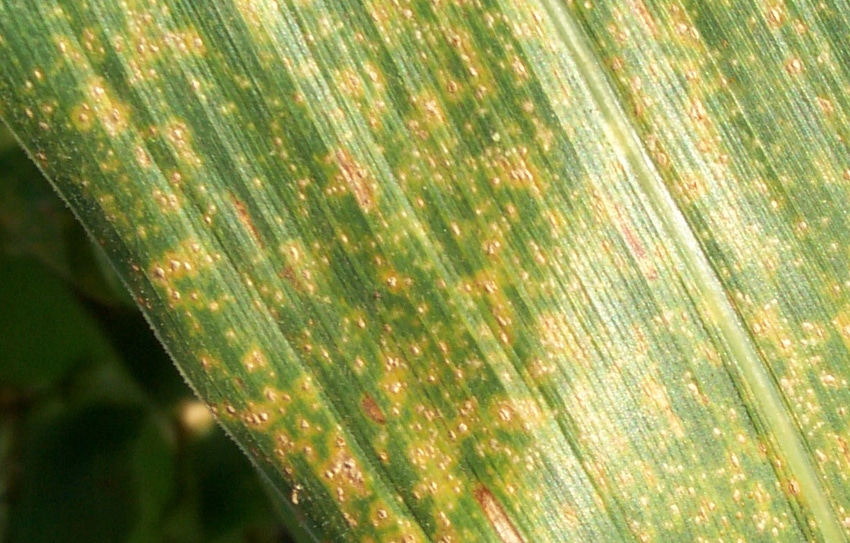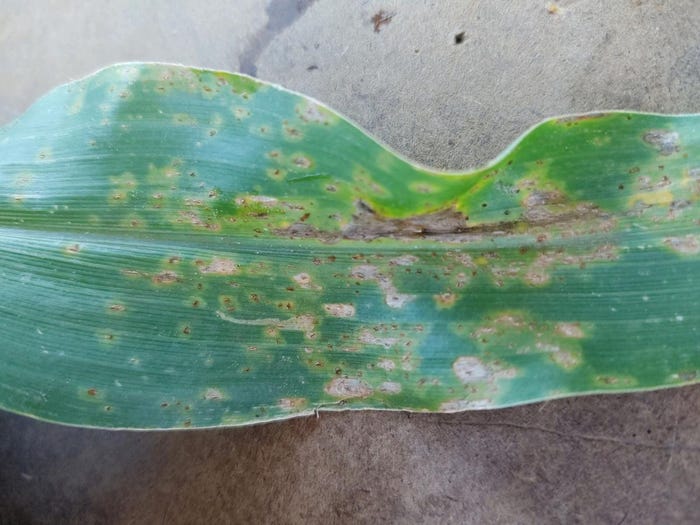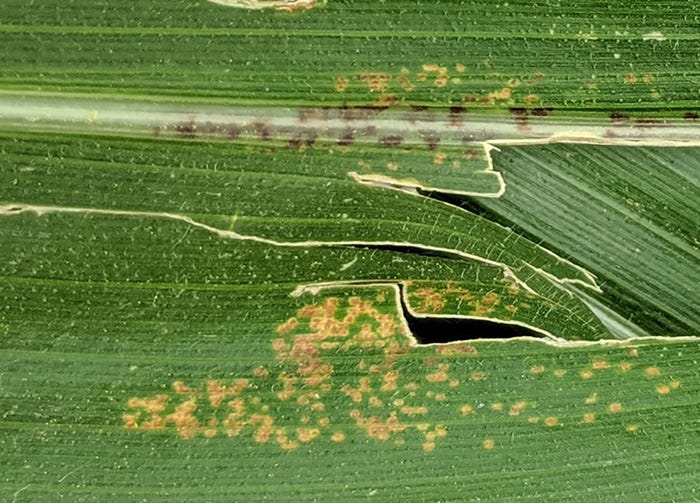July 29, 2019

Southern rust has now been confirmed in several states south and east of Nebraska during the prior weeks and has been active in deep southern states for several weeks.
The disease is currently at very low incidence in the fields from where samples were submitted. Warm, humid conditions may favor disease development, so fields in this area and elsewhere (especially in southern Nebraska) should be monitored frequently in the coming weeks for southern rust development.
Southern rust (Figure 2) is caused by an aggressive fungus that can rapidly cause disease in susceptible corn hybrids under favorable weather conditions. The disease can cause significant yield loss in susceptible hybrids if it becomes severe, so producers and crop advisors should monitor closely for this disease. Disease development is strongly impacted by weather conditions and sometimes does not become widespread or severe.
Southern rust does not always require treatment, making scouting and disease monitoring critical. It may take two or more weeks under favorable weather conditions for the disease to become more severe and widespread. Severe disease that impacts a large percent of leaf area can impact yield and stalk strength (standability) at the end of the season.

Southern rust pustules develop primarily on the top surface of the leaf and are generally orange to tan in color. (Photo by Jenny Rees)
Symptoms
Southern rust pustules are often numerous and tightly clustered in patches. They may appear tan to orange in color. Most spores are produced in raised rust pustules on the upper leaf surface. In contrast, common rust produces brick-red to brown spores on both the top and bottom of the leaves. Common rust has been found on corn samples from many areas across the state this year and sometimes has been more severe than in recent history due to favorable weather conditions during recent weeks. Some common rust pustules have obvious yellow haloes (Figure 3) around them that are more common with southern rust. Symptoms also may appear similar to Physoderma brown spot (Figure 4). This is leading to some confusion in identifying rust in the field. Microscopic examination in the diagnostic laboratory can quickly determine whether rust spores are those of common rust or southern rust.

Some corn hybrids with common rust (pictured here) may produce yellow haloes around rust pustules making them more difficult to differentiate from southern rust. (Photo courtesy of Aaron Keck)

Symptoms of Physoderma brown spot can appear similar to southern and common rusts. Shown here Physoderma exhibits brown-purple spots on the mid-rib (shown here) and leaf sheath and yellowish brown spots on the leaf (lower half of image). (Photo by Jenny Rees)
Favorable Weather
The rust pathogens do not overwinter here. Spores (urediniospores) must be blown into the area on winds from areas south of Nebraska. These fungi need moisture to germinate and infect, so high relative humidity, rainfall, and irrigation will hasten disease development. Warm temperatures also favor southern rust development, especially temperatures in the upper 70s to 80s F, which are optimal for the fungus, even if they occur during the overnight hours. Cooler and drying conditions will help slow disease spread. This was observed in 2018 when the disease was confirmed in Nebraska early in the growing season and failed to become widespread in most counties.
Monitoring
A new and more user-friendly southern rust tracking website has been created to monitor the distribution of the disease.
Please help us keep the map updated by sharing samples with suspected southern rust from your area. Counties from where southern rust samples have been microscopically confirmed are highlighted in red on the map.
Management
Most hybrids are susceptible to the southern rust fungus. Familiarize yourself with your hybrids’ anticipated reaction to the disease by reviewing hybrid ratings provided by the seed company.
Monitor disease in susceptible hybrids to determine which fields may need treatment. Foliar fungicides can effectively manage the disease. Most fungicides can provide protection of leaves from future infections for 21-28 days, so application timing is critical. Treating before disease develops may lead to loss of full product efficacy before the disease reaches a critical level. Treating too early can result in the need for reapplication later if the disease spreads and worsens after the time when the earlier fungicide application has worn off.
The wide range of planting dates across Nebraska this year has resulted in a wide range of corn growth and reproductive stages in fields, some of which are still in the vegetative growth stages. Later planted fields that are earlier in their maturity are at the greatest risk for yield loss if the disease develops there soon. Sometimes southern rust can take from several days to several weeks to develop, if at all, once it’s identified in an area. Treatment may not be necessary in vulnerable fields, so scouting is critical. Spraying early may mean a second application is necessary later in the season to protect plants during later grain-fill stages if the disease increases in severity once the fungicide has worn off. Scouting corn often is recommended to monitor for this and other diseases and their spread.
Sample Submission
Submit samples to the UNL Plant and Pest Diagnostic Clinic for help identifying this and other diseases if you are unsure of the diagnosis. Information on how to submit a sample and the sample submission form are available on the PPDC site.
Source: University of Nebraska-Lincoln
The source is solely responsible for the information provided and is wholly owned by the source. Informa Business Media and all its subsidiaries are not responsible for any of the content contained in this information asset.
You May Also Like




